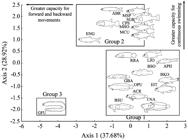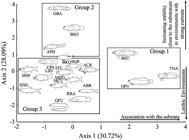The present study was based on the identification of the ecomorphological patterns that characterize the fish species found in tide pools in the Amazonian Coastal Zone (ACZ) in the Pará State, Brazil. Representatives of 19 species were collected during two field campaigns in 2011. The dominance, residence status, and trophic guild of each species were established, and morphometric data were obtained for up to 10 specimens of each species. A total of 23 ecomorphological attributes related to locomotion, position in the water column, and foraging behavior were calculated for the analysis of ecomorphological distance. Principal Component Analysis (PCA) was utilized for the evaluation of ecomorphological attributes that explained the variation among species. Mantel Test was used to correlate the taxonomic distance with species' morphological patterns and a partial Mantel Test to analyze the correlation among trophic guilds and ecomorphological patterns, controlling the effects of taxonomic distance among species. The analyses revealed two principal axes of the variation related to locomotion, correlated with the width of the caudal peduncle and the shape of the anal fin, as well as the influence of taxonomic distance on the ecomorphological characteristics of the different species. The dominant and resident species both presented a reduced capacity for continuous swimming. The two principal axes identified in relation to the position of the fish in the water column were correlated with the position of the eyes, the area of the pelvic fin, and body shape, with evidence of the influence of taxonomic distance on the morphology of the species. PCA grouped species with pelagic habits with benthonic ones. In the case of foraging behavior, the two principal axes formed by the analysis correlated with the size of the mouth, eye size, and the length of the digestive tract. Species of different guilds were grouped together, indicating a weak relationship between morphology and foraging behavior, and no relationship was found with taxonomic distance. The resident and dominant species in the tide pools of the ACZ present sedentary habits, with little evidence of the influence of taxonomic distance on the use of habitats or morphology, which was a poor indicator of foraging strategies, and showing that phylogenetically distant species could present similar ecomorphological patterns.
Ecomorphology; habitat use; resource partitioning; intertidal zone; estuaries

 Thumbnail
Thumbnail
 Thumbnail
Thumbnail
 Thumbnail
Thumbnail
 Thumbnail
Thumbnail



